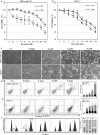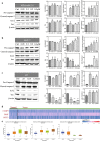Relation of AURKB over-expression to low survival rate in BCRA and reversine-modulated aurora B kinase in breast cancer cell lines
- PMID: 31244554
- PMCID: PMC6582545
- DOI: 10.1186/s12935-019-0885-z
Relation of AURKB over-expression to low survival rate in BCRA and reversine-modulated aurora B kinase in breast cancer cell lines
Abstract
Background: New therapeutic drug for breast cancer (BRCA), especially triple negative BRCA (TNBC), is urgently needed. Even though 2-(4-morpholinoanilino)-6-cyclohexylaminopurine (reversine) is an aurora kinase inhibitor, it also inhibits some cancer cells and human BRCA cells. However, the potential roles of reversine as a novel therapeutic agent for the treatment of BRCA remains unknown and must be further investigation. Thus, the relationship of reversine to aurora kinase in BCRA has not been reported. The relationship between AURKB and survival rate in BRCA has never been reported. Herein, we tested the roles of reversine on different BRCA cell line subtypes. We also investigated the relationship between AURKB and survival rate in BRCA as well as reversine to Aurora kinase expression in BCRA cell lines, including TNBC subtype, 4T1, MDA-MB-231, and luminal subtype MCF-7.
Methods: Cell viability and apoptosis were detected using Cell Counting Kit-8 and flow cytometry analysis, respectively. Apoptotic and tumor-related proteins were tested using Western blot analysis. Important microRNAs that regulate BRCA were analyzed using RT-PCR. UALCAN public databases were used to analyze the targeted gene profiles, and the PROGgeneV2 database was used to study the prognostic implications of genes.
Results: Reversine inhibits cell proliferation and induces cell apoptosis by modulating caspase-3 and bax/bcl-2 among the three cell lines. Data from the UALCAN public database show that BRCA tissues expressed high gene levels of AURKB, TIMP1, MMP9, and TGFB1 compared with the normal tissue. Among the over-expressed genes in BRCA, AURKB ranks 9th in TNBC, 49th in luminal subtype, and 48th in HER2 subtype. High AURKB level in BRCA is highly related to the low survival rate in patients displayed in 18 databases searched via PROGgeneV2. The protein levels of aurora B kinase (Aurora B), which is encoded by AURKB gene, are highly suppressed by reversine in the three cell lines. The tumor-related proteins TGF-β1, TIMP1, and MMP9 are partially suppressed by reversine but with different sensitivity in the three cell lines. The reversine-affected microRNAs, such as miR129-5p, miR-199a-3p, and miR-3960, in MDA-MB-231 cell line might be the research targets in TNBC regulation.
Conclusions: In BRCA, the level of AURKB are over-expressed and is related to low survival rate. Reversine contributes to anti-growth effect in BRCA cell lines, especially for TNBC, by modulating the aurora B. However, the invasiveness, metastasis, and anti-tumor effects of reversine in vivo and in vitro must be further investigated.
Keywords: AURKB; Aurora B; BRCA; Reversine; Triple-negative breast cancer cells; microRNAs.
Conflict of interest statement
Competing interestsThe authors declare that they have no competing interests.
Figures






Similar articles
-
Aurora Kinase B Inhibition: A Potential Therapeutic Strategy for Cancer.Molecules. 2021 Apr 1;26(7):1981. doi: 10.3390/molecules26071981. Molecules. 2021. PMID: 33915740 Free PMC article. Review.
-
Targeting glioma cells by antineoplastic activity of reversine.Oncol Lett. 2021 Aug;22(2):610. doi: 10.3892/ol.2021.12871. Epub 2021 Jun 15. Oncol Lett. 2021. PMID: 34188712 Free PMC article.
-
Reversine exerts cytotoxic effects through multiple cell death mechanisms in acute lymphoblastic leukemia.Cell Oncol (Dordr). 2020 Dec;43(6):1191-1201. doi: 10.1007/s13402-020-00551-3. Epub 2020 Aug 28. Cell Oncol (Dordr). 2020. PMID: 32857324
-
Role of AURKB Inhibition in Reducing Proliferation and Enhancing Effects of Radiotherapy in Triple-Negative Breast Cancer.Breast Cancer (Dove Med Press). 2024 Jul 9;16:341-346. doi: 10.2147/BCTT.S444965. eCollection 2024. Breast Cancer (Dove Med Press). 2024. PMID: 39006183 Free PMC article.
-
Mitotic syndicates Aurora Kinase B (AURKB) and mitotic arrest deficient 2 like 2 (MAD2L2) in cohorts of DNA damage response (DDR) and tumorigenesis.Mutat Res Rev Mutat Res. 2021 Jan-Jun;787:108376. doi: 10.1016/j.mrrev.2021.108376. Epub 2021 Apr 24. Mutat Res Rev Mutat Res. 2021. PMID: 34083040 Review.
Cited by
-
EHMT2-mediated R-loop formation promotes the malignant progression of prostate cancer via activating Aurora B.Clin Transl Med. 2025 Jan;15(1):e70164. doi: 10.1002/ctm2.70164. Clin Transl Med. 2025. PMID: 39763034 Free PMC article.
-
Aurora Kinase B Inhibition: A Potential Therapeutic Strategy for Cancer.Molecules. 2021 Apr 1;26(7):1981. doi: 10.3390/molecules26071981. Molecules. 2021. PMID: 33915740 Free PMC article. Review.
-
Identification of extracellular vesicles-transported miRNAs in Erlotinib-resistant head and neck squamous cell carcinoma.J Cell Commun Signal. 2020 Dec;14(4):389-402. doi: 10.1007/s12079-020-00546-7. Epub 2020 Mar 10. J Cell Commun Signal. 2020. PMID: 32157550 Free PMC article.
-
AURKB activates EMT through PI3K/AKT signaling axis to promote ICC progression.Discov Oncol. 2023 Jun 15;14(1):102. doi: 10.1007/s12672-023-00707-1. Discov Oncol. 2023. PMID: 37318676 Free PMC article.
-
Targeting glioma cells by antineoplastic activity of reversine.Oncol Lett. 2021 Aug;22(2):610. doi: 10.3892/ol.2021.12871. Epub 2021 Jun 15. Oncol Lett. 2021. PMID: 34188712 Free PMC article.
References
LinkOut - more resources
Full Text Sources
Research Materials
Miscellaneous

